-
{{ item.text }} {{ item.text }}

(*) NFBC: Cutline strategy 2023
The Cutline format is one of the National Fantasy Baseball Championship's (NFBC) most famous contests, attracting players with its combination of low-maintenance and relatively small league sizes. While having a shallower player pool than the larger best-ball tournaments, the competition is no less fierce. Let's dive in and explore opportunities to find an edge.
Know the Format
If you've heard it once, you've heard it a million times — "Know the rules." Because the Cutline is unorthodox, it's essential to make sure you understand the details. One distinction is that the contest ends two weeks before the season ends (after 25 weeks). In addition, here are the critical dates for the 2023 version:
- April 11 - FAAB #1 (after two weeks)
- June 6 - FAAB #2 (after 10 weeks)
- July 12 - League scoring ends (first cut, after 15 weeks)
- July 13 through September 17 - Championship period (three separate cuts, every three weeks)
Tools. Analysis. Commentary. And most of all—a tradition of winning. Access it all with a subscription to BaseballHQ.com.
What's Worked Before?
One great way to attack these big overall contests is to investigate what past winners have done. The Cutline divides its scoring into two parts - a "league" portion that runs until the All-Star break (July 11 this year) and a "championship" portion that runs until the end of the season for those who make the cut. The "League" portion is your optimized sum through the first 15 weeks (before the initial paring). Provided you survive, you will retain parts of your previous score combined with your current total. These numbers are the averages from the top 20 overall finishers over the last two years (40 teams). Because the championship scores aren't quite as simple as "total points" due to the scoring format, let's look at both portions separately:
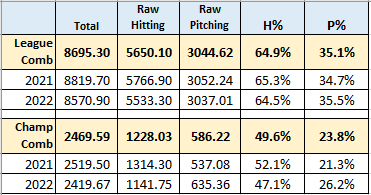
For our analysis, let's look at the "League" part. If we split the hitting score from the pitching score, we can begin to understand what our hitters and pitchers need to do to put us in a winning position after we advance. Since the league component considers the first 15 weeks, we divide these amounts by 15 to create a weekly total. We then divide these weekly totals by the number of starting roster positions to get our weekly target per starting roster slot (SRS).

We can also look at what types of players successful teams selected by looking at what categories they scored in. The table below shows teams benefited from all stats - which debunks the idea that players should avoid relievers and solely take starting pitchers or that we should shun base stealers in favor of power bats. While building around power is still a core strategy, remember that players who do more "things" (i.e., hit and run) are more likely to produce constant value each week. Relievers - with multiple possible appearances any given week - may be more prone to return consistent scores, while pitchers on two-start weeks will have chances to spike the high totals we'll need to hit our goals. So while we don't have the direct challenge of managing rotisserie categories, striving for balance can still gain an indirect advantage.
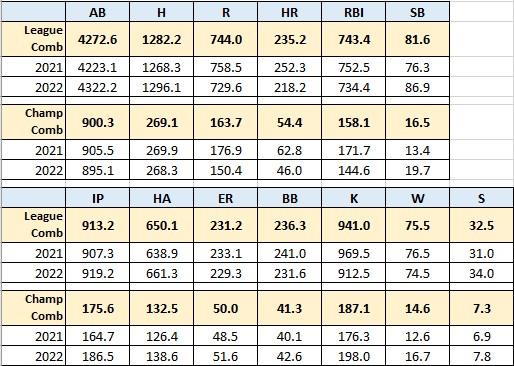
Now let's look at roster construction. For the sake of simplicity, we'll split the player pool into hitters and pitchers:
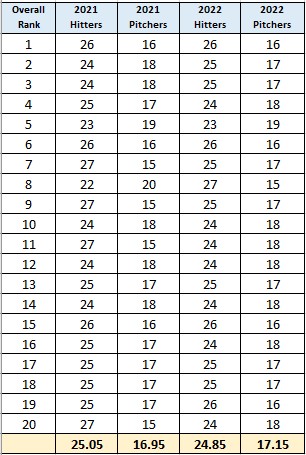
Since our starting lineups are more heavily weighted toward hitters, it makes sense that we would roster more bench hitters. Optimization reminds us to continue adding quality players even after we've filled out our "starters" - because we are constantly looking for players to help us achieve those weekly target goals. This generally applies to hitters, but don't be afraid to add great pitching values as they appear.
Thinking about the Draft
Now that we have direction on how many hitters (and, therefore, pitchers) to draft, we must decide which positions to prioritize. Joe Pisapia was one of the first to explore the topic of Relative Positional Value (RPV) and bring it to mainstream fantasy baseball. By boiling a player's worth down to one number, RPV works well with points leagues because you don't have the added complexity of balancing rotisserie categories. RPV allows you to compare what positions provide the most value. While RPV delivers how the information is displayed, your projections are at the heart of what drives your draft decisions. By employing BaseballHQ's projections, you can ensure that you extract the most value per position, while your opponents may simply look at total points.
While RPV aids us in one facet of our decision-making process, we must also consider the market (ADP) to acquire as many of our targets as possible. Once we compare our projection-inspired point totals to ADP, we'll have uncovered another level of determining value - we'll know what high-value players we should take aggressively and which we can wait a bit longer on.
Building Depth
We'll likely notice a premium for multi-eligible players as we compare our values to the market. We know they're valuable - but how valuable? Worth 50 points? Is 1B/OF more or less worthy than 2B/SS? Since much of this is debatable (and largely indeterminable), let's focus on the big picture to help us with these decisions.
If we have 25 spots to spend on hitters, we want as many players at each position to help us maximize our score each week. A good target would be around 30 hitter eligibilities (4 C / 16 IF / 10 OF). However, all "coverage" is not created equal, and we want to be sure that every player we draft adds as much value to our team as possible. Maximizing value means you avoid sacrificing ground you would gain with superior players to acquire backup spots - however, be sure to pay attention to the available draftable supply of players in each group.
For example, say Ha-Seong Kim is the last undrafted player from your "MI pool." In comparison, he's projected for 45 fewer points than Michael Conforto (with a similar ADP). Taking Kim ensures you keep pace with your league at MI and provides depth at multiple positions for a front-end cost of 45 points. You notice that numerous OF options should be available later for 10 points less than Conforto, which is less than 15 point advantage Kim has over the next MI-eligible player. Plus, Kim has the added benefit of 3B eligibility and is currently set to play 2B. Less constrained by positional requirements allows for even more opportunities to add the best available players with future picks. So, by taking a 45-point loss at face value, we've actually gained 5 points overall (as you never get sniped in hypothetical scenarios!) and potentially even more.
There are a few other savvy tactics you can use to add quality depth to your roster. One way is to consider prioritizing eligibility when it presents itself in earlier rounds. This way, your interchangeable parts are top players and can alleviate some pressure to reach for positions later on when the talent starts to wane. Shohei Ohtani is a prime example of this type of flexibility - as no other player can produce both as an elite hitter or pitcher. Unfortunately, you'll likely need the first pick to get him in this format - but keep your eye out for other opportunities in the early rounds to take advantage. Another way to add value is to note players projected to be everyday players at positions they aren't yet listed. Jazz Chisholm is set to play CF for Miami, and Gavin Lux is projected to be the everyday SS for LA. These are just a couple of examples; keep your eyes peeled for spring training quips (PT Today/Tomorrow are great resources) on where players are getting reps - this is apt to create some market discounts.
Weighing Variance vs. Risk
In overall contests, we know we need to build our teams with upside to give ourselves the best chance to place. Some drafters confuse players with variance, or a relatively extensive range of outcomes, with players who fall in the draft but must overcome long odds to provide value. A couple of these considerable risks are injuries and playing time.
By removing the top 250 hitters and 170 pitchers (25 hitters per team, 17 pitchers per team) by ADP, then sorting by Projected points, we get the following replacement player values:
- Hitter (average of 251-260): 13.90 points/week
- Pitcher (average of 171-180): 10.55 points/week
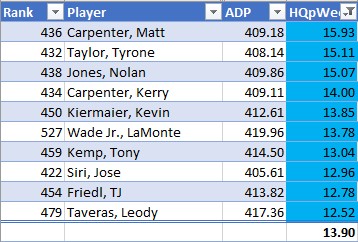
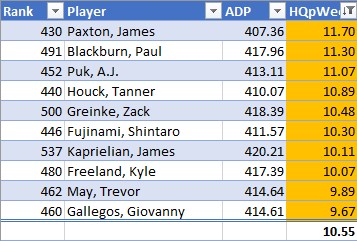
These values represent each player slot's opportunity cost per week, based on each team drafting 25 hitters and 17 pitchers. Consider this when selecting a top pitcher with reported injury concerns in spring training or a prospect who expects a call-up in the first few weeks. Instead, build upside with players who could return massive value if they overperform - and reduce the likelihood of taking zeroes if they don't.
What to do about FAAB?
The broad strokes regarding FAAB strategy will largely depend on the time between your draft and opening day; and how lucky you are with injuries. Early drafts can be an equalizer - as the lack of information could severely handicap anyone's roster before the season even begins. If you are one of the unfortunate managers to take an unexpected injury to a key player, you will likely have to be aggressive. There's no need to be prudent with your FAAB, as you will need all hands on deck if you want to finish in the top half.
If you have avoided any significant landmines over the first two weeks, then you have the luxury of taking more of a "general housekeeping" approach. Remember, the points you score over the first fifteen weeks impact your total in the championship round, so make sure your roster works as hard as possible to churn out points.
The second FAAB is much more straightforward - since there is no reason to hold back. You'll have more information from the first bidding round; you'll have to set up contingency lists to ensure you maximize every dollar. You'll likely have some decisions to make with injury timelines and prospects - some risks are worth taking to finish on the leaderboard; just be sure you understand what you are passing up for the promise of something more. Only you can decide what path leads to the best chance for victory.
Putting it All Together
All in all - the Cutline provides an excellent test of strategy. It allows for opportunities to gain an edge over your league mates via the draft and FAAB - with the relative ease of "kick your feet back and let the optimizer do its thing." Sure, you'll have moments where you'll need to be at your best to compete - but it condenses the "grind" to a couple of nights (or weeks, more accurately) compared to a grueling six months. Take these tips, and with some luck - draft a winner!
(NFBC ADP Data reflects all Cutline drafts completed through February 18).







